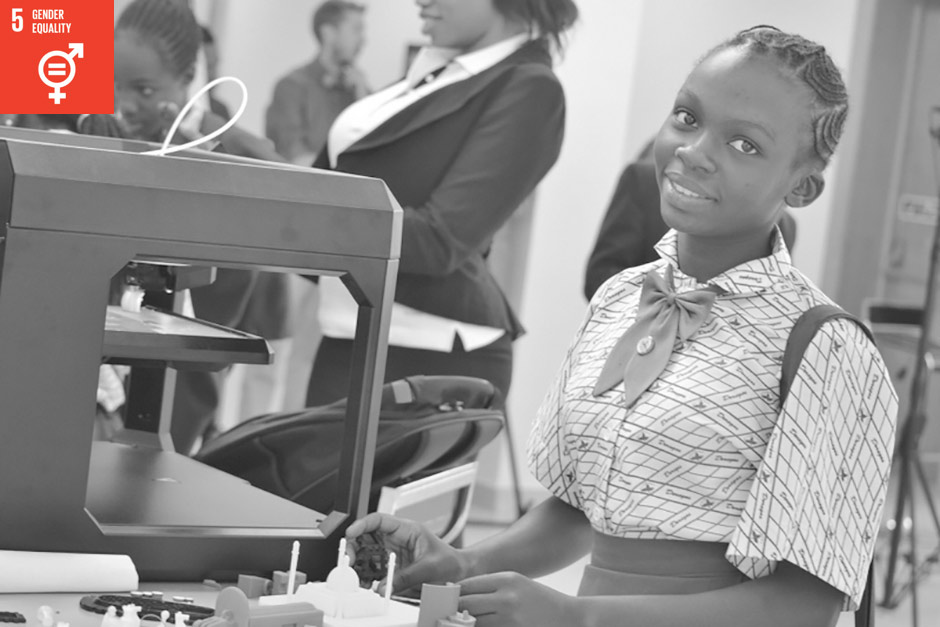

(Editor’s note: This post is part of a series covering YTF’s work with the United Nation’s Sustainable Development Goals. See more of the series here.)
STEM Education—YTF Academy. Female representation is low at all levels of the STEM career pipeline, from interest and intent to majoring in a STEM field in college to having a career in a STEM field. Studies show that girls lose interest in math and science during middle school, and that STEM interest for girls is low compared to boys. However:[1]
- 74% of girls are interested in STEM topics
- Girls are interested in learning, asking questions, hands-on activities, and problem solving
- They want to help people, make a difference
- Girls interested in STEM have supportive adult networks and are exposed to STEM fields
- Minority girls have high interest in STEM, high confidence, and strong work ethics, but have fewer supports and less exposure to STEM fields
Job forecasts show that training in STEM jobs will be in great demand in the immediate and near future. “Technology is omnipresent in today’s society—over 95% of jobs have a digital component.”[2] Training in technology is critical—especially for girls. Although girls and women are using technology more than ever before, the percent of women earning technology degrees is falling: in 1985, it was 37%, today it is only 14%.[3]
Although women are the majority of the workforce, they are significantly underrepresented in engineering: only 13% of civil engineers and 6% of mechanical engineers are women. However, girls’ natural interests are perfect inspirations and match for engineering fields: 38% of girls love to make things, 34% want to increase their knowledge, and 32% want to solve problems.[4] Girls that make, design, and create using technology develop stronger and greater interests in computer science and engineering fields.
Researchers and experts in STEM education agree that boosting the number of women in STEM fields would expand the world’s pool of innovators for the future, bring a new dimension to the work, and potentially tackle problems that have been overlooked in the past. Many girls and their teachers don’t know what engineering is or the reality of making this a career choice—only 3% of girls who identify as not interested in STEM would choose engineering. Engineering is a field that allows girls to actualize their dreams of making a difference, collaborating, and helping people, all while making a great salary: “…our work must now turn to transforming this interest into action.”[5]
3D Africa. Businesses are seeking female engineers and inventors to tackle its toughest challenges and to solve problems of today and for tomorrow. Introducing girls to 3D printing is an engaging activity that inspires them to choose STEM and engineering careers. Inventors, engineers, musicians, medical scientists, artists, researchers, and manufacturers have been using 3D printing for many years to determine if an idea will work at a fraction of the cost and time. YTF’s 3D Africa engages girls in technology through natural interests of making, creating, and inventing. 3D printing is a vanguard, threshold opportunity for girls: there are “exceptionally few engineers” who know how to create the data needed to run 3D manufacturing designs.[6]
Through years of first-hand observation in developing countries with high rates of unemployment and poverty, YTF has seen that innovation frequently comes from the unavailability of resources and pure necessity. Due to lack of jobs, high unemployment rates, or low levels of education, innovation is born from constraints. In Africa, as an example, this has bred a generation of problem solvers and innovators—a generation of young people who are faced with challenges, but still find solutions that work. YTF’s 3DAfrica has inspired many new innovators and entrepreneurs. It is YTF’s vision to connect innovation with low-income, disenfranchised, and at-risk youth.
YTF programs are problem-based, providing the springboard to innovation through understanding and empathizing with community, individual, at-risk peoples, and social needs, issues, and problems. By using real-world case study scenarios, YTF helps participants to ask the right questions in the design thinking and design processes. Solutions frequently fail because wrong questions were asked by design teams—real-world case study-based design thinking teaches participants to ask the right questions based on real data, real people, real situations, and real barriers.
Engaging youth in innovative STEM programs strengthens and sustains their interest in, and ultimate involvement in, STEM careers. 3D printing could potentially “mitigate the unemployment situation in Africa by bridging the gap between education and employment.”[7]
Important Read—Ashoka Changemakers Blog, October 8, 2015: “A girl is questioned, even told she’ll never get a husband, if she’s studying science,” Harry said. “But the girls we work with are innovating and designing and empathizing and building real products in a safe place. They’re learning math and science in a fun and exciting way. And communities begin to see girls as agents of change.”[8]
TechCrunch, January 26, 2015: Youth for Technology’s 3D Africa Program Wants to Get More Girls Into STEM Subjects.
Ashoka Changemakers Video: Global Goals #5: Gender Equality—Can you make it happen?
